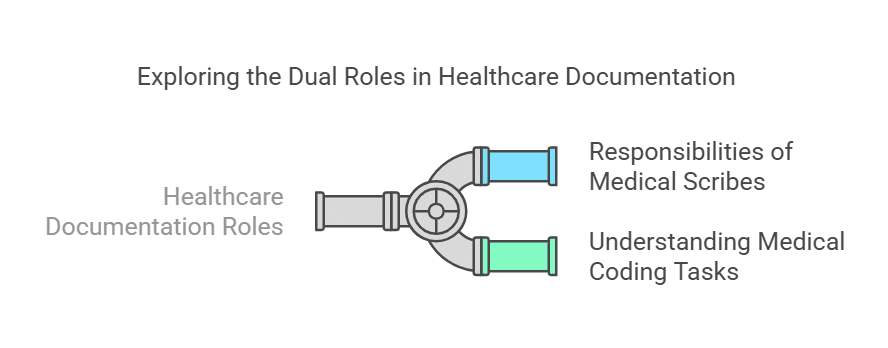On-Demand Outsourcing BPO Services for Healthcare Providers With 24/7 Coverage!
Save up to 70% on staffing costs!
Browse Specialty Staffing ServicesCan Medical Scribes Also Perform Coding Tasks?

The healthcare industry is constantly evolving, with roles often adapting to meet changing demands. Can Medical Scribes Also Perform Coding Tasks? Medical scribes and medical coders play distinct but equally important parts in the healthcare process. Yet, as healthcare organizations push for greater efficiency, there’s growing interest in whether these roles can overlap. Could medical scribes be trained to take on coding tasks? Let’s unpack this idea and see if combining these responsibilities is a practical solution.
Key Responsibilities of Medical Scribes
Medical scribes act as the right-hand assistants to healthcare providers when it comes to documentation. Their main goal is to ensure that providers can focus more on patient care and less on administrative tasks. Scribes do this by recording patient encounters in real time, usually during office visits or procedures.
They transcribe detailed notes about the patient’s complaints, history, diagnoses, and treatment plans as the encounter unfolds. Accuracy and speed are critical, as these records become part of the patient’s permanent medical history. Besides documenting visits, scribes also organize patient records, update charts, and ensure compliance with documentation standards.
In short, medical scribes improve provider efficiency by easing the documentation burden—but their work focuses on recording, not interpreting, clinical information.
Understanding Medical Coding Tasks
Medical coders, on the other hand, work behind the scenes to ensure healthcare services are properly represented in billing and compliance systems. Coders take the medical services, procedures, and diagnoses recorded in a patient’s documentation and translate them into standardized codes. These codes are required for billing insurance companies, ensuring accurate reimbursement, and maintaining compliance with healthcare regulations.
Coders must have a deep understanding of medical terminology and coding guidelines to avoid errors. Even small mistakes in coding can lead to claim rejections, delays in payment, or potential compliance issues. The job demands close attention to detail and knowledge of specific coding systems that are universally used in the healthcare industry.
Major Coding Systems Used by Medical Coders
Medical coders use three primary coding systems:
- ICD (International Classification of Diseases): Used to classify diagnoses and medical conditions.
- CPT (Current Procedural Terminology): Focuses on medical procedures and services.
- HCPCS (Healthcare Common Procedure Coding System): Covers services, equipment, and supplies not included in CPT codes.
These coding systems require ongoing education to keep up with updates and changes, as they’re essential for proper billing and reimbursement.
Overlap Between Scribing and Coding Roles
So where do medical scribes and coders intersect? The key is in their shared reliance on medical documentation. While coders focus on extracting and interpreting clinical data for billing, scribes are already deeply familiar with the language of medical records.
A medical scribe’s thorough knowledge of terminology and documentation standards could position them to handle basic coding tasks. For example, a scribe who is trained in coding might identify and enter appropriate CPT codes during the documentation process, speeding up the workflow for the primary coder or medical billing team.
That said, scribes and coders approach documentation from very different angles. Scribes prioritize accuracy in capturing what’s said during patient visits, while coders must interpret and classify data based on complex coding rules.
Challenges in Combining Scribing and Coding Roles
Merging these roles isn’t without potential difficulties:
- Varied Expertise: Traditional scribes aren’t trained in the detailed coding guidelines required for billing compliance. Meanwhile, coders focus less on real-time transcription and more on data analysis. Bridging this gap would require significant training.
- Error Risks: Coding demands precision. Allowing untrained or lightly trained scribes to code could lead to billing errors, which could delay payments or even result in fines.
- Time Constraints: Scribes already have their hands full capturing detailed patient notes in real-time. Adding coding responsibilities might reduce their efficiency or cause burnout.
Benefits of Training Scribes in Coding Skills
Despite these challenges, cross-training scribes in basic coding could offer notable advantages:
- Streamlined Workflows: A scribe who can enter preliminary codes during documentation could save time for coders and improve the efficiency of the billing process.
- Cost Savings: Hiring cross-trained staff might reduce the need for separate employees to handle documentation and coding tasks.
- Improved Documentation Accuracy: Familiarity with coding systems could help scribes document more complete and accurate medical records, which benefits billing and compliance.
For success, training would need to emphasize coding fundamentals without overloading scribes with responsibilities better suited to full-time coders.
Future Trends in Role Integration
As technology advances, the lines between scribing and coding may blur further. Tools like electronic health records (EHRs) and AI-driven software are already automating parts of documentation and coding. In the future, these innovations could make it easier—and safer—for scribes to take on coding responsibilities.
AI-assisted tools that suggest codes based on patient records, for example, could act as a bridge between scribing and coding. These systems could supplement human expertise, minimizing errors while increasing productivity.
However, even with advanced tech, the need for trained professionals who understand the nuances of both roles will remain essential.
What Did We Learn?
The question of whether medical scribes can perform coding tasks boils down to training, compliance, and organizational priorities. Scribes already excel in documenting healthcare encounters, and their familiarity with medical terminology gives them a potential head start in coding.
However, combining these roles isn’t without its challenges. Differences in expertise, workload, and the potential for errors must be carefully addressed. With proper cross-training and safeguards, scribes could become valuable assets in coding, enhancing efficiency and lowering costs for healthcare organizations.
As technology continues to evolve, we could see more integration between these roles. For now, the decision to have scribes take on coding tasks should be made thoughtfully, keeping both operational goals and compliance standards in mind.
FAQs
What is the primary role of a medical scribe?
A medical scribe documents patient encounters in real-time, ensuring the physician’s notes are accurately recorded in the electronic health record (EHR).
How does medical coding differ from medical scribing?
Medical coding involves translating diagnoses, procedures, and treatments into standardized codes for billing and insurance purposes. Scribing focuses on documentation rather than coding.
Can a medical scribe also perform medical coding?
While some scribes may have coding knowledge, medical coding requires specialized training and certification to ensure accuracy and compliance with regulations.
Why is it important to keep scribing and coding separate?
Mixing the two roles can lead to errors, inefficiencies, and compliance risks. It’s best to have trained coders handle medical coding while scribes focus on documentation.
How can outsourcing help with medical documentation and coding?
Outsourcing to a trusted provider like Staffingly, Inc. ensures that both scribing and coding are handled by experts, improving efficiency, accuracy, and revenue cycle management.
Disclaimer
For informational purposes only; not applicable to specific situations.
For tailored support and professional services,
please contact Staffingly, Inc. at (800) 489-5877
Email : support@staffingly.com.
About This Blog : This Blog is brought to you by Staffingly, Inc., a trusted name in healthcare outsourcing. The team of skilled healthcare specialists and content creators is dedicated to improving the quality and efficiency of healthcare services. The team passionate about sharing knowledge through insightful articles, blogs, and other educational resources.
 Book a Demo to Build Your Team Today!
Book a Demo to Build Your Team Today!
 Read Case Studies
Read Case Studies 



 Virtual Medical Assistants
Virtual Medical Assistants



